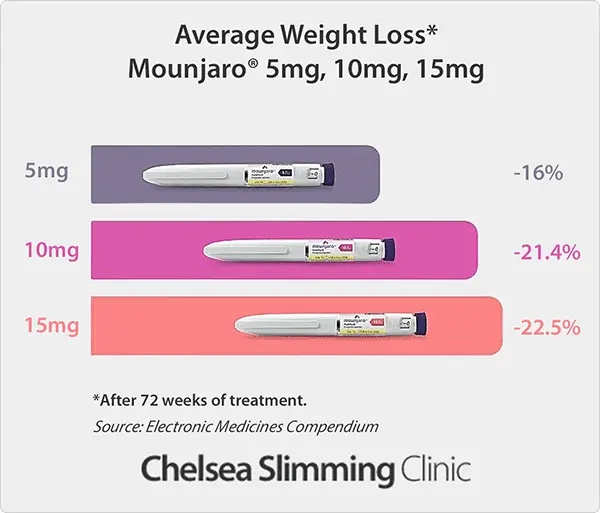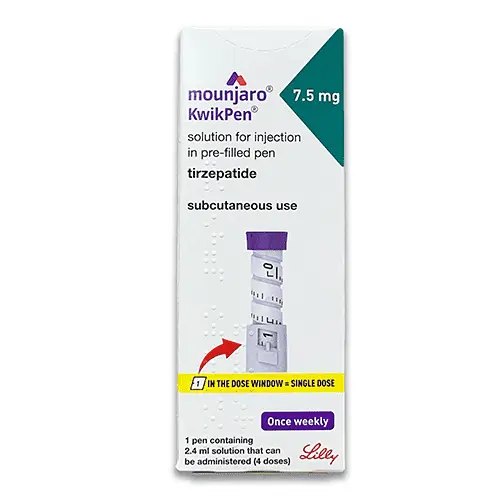Quick Navigation
Mounjaro Weight Loss Results: What to Expect
Patients often ask, “How much weight will I lose with Mounjaro?” While individual results vary, clinical trials and real-world data show that, when combined with lifestyle changes, Mounjaro supports meaningful, long-term weight loss.
-
Weeks 1–12: Building Foundations
Your body begins adjusting to treatment.
- Weight loss typically starts at 1–3 lbs per week
- Tolerance builds as doses increase
- A healthy diet and more physical activity begin to feel manageable
-
Months 3–6: Visible Progress
With a therapeutic dose, results become more noticeable.
- Average loss: 9–11% of starting weight
- Clothes fit better, and energy improves
- Many see better control of blood pressure , cholesterol , and blood sugar
-
After 6 Months: Long-Term Success
At maintenance dose, focus shifts to sustainability.
- Trials show up to 21% total weight loss by 12–18 months
- Long-term success comes from balanced eating, portion control, and regular movement
Mounjaro isn’t a quick fix — it’s a tool that, alongside the right support and habits, helps restore health and improve quality of life.
Mounjaro Treatment Plan
Your treatment plan is designed to support steady weight management while minimising the risk of serious side effects like stomach pain or low blood sugar. Think of it as your personalised roadmap—we’re here to guide you every step of the way.
How Weekly Dosing Works
Mounjaro is taken once a week using the Mounjaro KwikPen. You’ll start on a 2.5mg dose, which helps your body adjust with fewer side effects.
After 4 weeks, the dose may be increased to 5mg, and then if tolerated well—may rise by 2.5mg every 4 weeks , up to a maximum recommended dose of 15mg.
5mg → 7.5mg → 10mg → 12.5mg → 15mg
Key tips to follow:
- Stick to the schedule: inject once weekly on the same day, with or without food.
- Never exceed the 15mg maximum—higher doses increase the risk of severe side effects.
- Stay consistent: it helps maintain steady medication levels and supports the best results.
Finding Your Ideal Maintenance Dose
Not everyone needs to reach the full 15mg. If you're hitting your weight loss goals and managing appetite well on 5mg or 10mg, that may be your ideal maintenance dose.
What to expect:
- Different doses work differently for different people—your response guides the plan.
- Clinical studies show average weight loss varies depending on dose level over 72 weeks.

How to Inject Mounjaro Safely Using the KwikPen
Administering your Mounjaro injection at home is simple once you know the routine. The Mounjaro KwikPen is a weekly self-injectable pen designed for accuracy and ease, helping support effective treatment with minimal discomfort.
When used correctly, it reduces the risk of injection site reactions such as redness, swelling, or tenderness. Here's everything you need to know.
Your Weekly Injection Routine

Follow these key steps to ensure safe, comfortable injections — and reduce the risk of complications:
-
Rotate injection sites
Switch between your abdomen, thigh, or upper arm each week. Avoid injecting in the same spot two weeks in a row, as this lowers the risk of injection site reactions. -
Check the dose knob
Before each injection, make sure the dose knob on your injection pen is set to the correct amount prescribed by your clinician. This ensures accurate and consistent dosing. -
Inject with care
Place the pen firmly at a 90-degree angle to the skin, press the button until it clicks, and hold it there for 10 seconds to ensure the full dose is delivered. Using a fresh needle each time reduces the chance of infection. -
Dispose properly
Immediately place used pens and needles into a sharps bin. Never throw them into general household waste — safe disposal keeps your home environment protected.
For full step-by-step instructions, always refer to the patient information leaflet provided with your prescription.
Remember: Never share your injection pen, even with clean needles.
Storing Your Mounjaro KwikPens Properly
To ensure your weight loss injections stay safe and effective, it’s important to store your Mounjaro KwikPens correctly from the moment they arrive. At Chelsea Slimming Clinic, we ship every pen in secure, temperature-controlled packaging — but proper storage at home is just as essential.
Storage Guidelines for Mounjaro
- Keep unused pens refrigerated at 2°C to 8°C until the expiry date.
- Alternatively, you may keep a pen at room temperature (up to 30°C) for up to 30 days.
- Never freeze the pens or leave them in direct sunlight or near heat sources.
- After your first dose, the same pen can stay in the fridge or at room temperature — make sure to use it within 30 days of opening.
Always check the expiry date before each injection.
Safe Disposal of Used Pens
After your injection:
- Place the used pen in a sharps bin — not in the household waste.
- A sharps bin can be requested when placing your first order with us.
- When your bin is around three-quarters full, return it to a local pharmacy, GP practice, or NHS sharps collection point.
Remember: Store all pens safely out of reach of children, and never use a pen past its expiry.
Mounjaro Side Effects: What You Should Know
Like all prescription medicines, Mounjaro injections can cause side effects — though not everyone will experience them. Most reactions are mild, especially when starting or after a dose increase, and tend to settle as your body adjusts. Still, it’s important to know what’s normal and when to get medical advice. For a full list of potential side effects, what they mean, and how to manage them, read our detailed guide.
Common Side Effects of Mounjaro
When starting treatment or increasing your dose, you may experience digestive side effects, which are generally short-lived. These include:
- Feeling sick (nausea)
- Mild stomach pain, bloating, or indigestion
- Diarrhoea or constipation
- Heartburn, burping or reflux
- Feeling more tired than usual
- Feeling light-headed or having low blood pressure
- Injection site reactions – mild redness, swelling or itching
- Low blood sugar (especially if you take insulin or certain diabetes medications)
These side effects are usually manageable and improve with time. Eating smaller meals and staying hydrated may help reduce stomach symptoms.
Less Common Side Effects
While less frequent, some patients report:
- Hair thinning
- Changes in appetite or bowel habits
- Gallstones or upper abdominal discomfort
- Mild allergic reactions (rash or itching)
- Raised enzyme levels in blood tests (lipase, amylase linked to pancreas activity)
Your care team may monitor these during your check-ups, especially if you're on long-term treatment.
Serious Side Effects – When to Seek Medical Help
In rare cases, serious side effects of Mounjaro can occur. Seek urgent medical advice if you notice:
- Acute pancreatitis – sudden, severe and persistent stomach pain, possibly with vomiting
- Severe allergic reactions – swelling of the face, lips, or throat, difficulty breathing, or hives
- Ongoing vomiting, diarrhoea, or signs of dehydration
- Repeated episodes of very low blood sugar
- Feeling full quickly, bloating after small meals, or vomiting food hours later – possible signs of gastroparesis or bowel blockage
Important: If you have a history of pancreatitis or gallbladder issues, inform your clinician before starting Mounjaro. We suggest closer monitoring or an alternative treatment.





